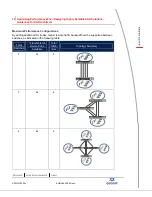
2
Optimizing Performance When Designing Highly Scalable SAN Solutions:
Guidelines for SAN Architects
SPG-WP06004 SN0130924-00
Rev
A
Scalability vs. Performance
This white paper provides guidelines for SAN architects to optimize performance when
designing highly scalable SAN solutions. Although this white paper focuses on Fibre
Channel switches, its concepts also apply to technology products like Ethernet switches
and will be familiar to technical staff in that field.
SAN solutions continue to grow in size and complexity to meet the ever-increasing
demands for storage capacity. Before the advent of stackable switch solutions, SAN
architects were faced with the design tradeoff of scalability versus performance.
Then: The Dilemma of Scalability vs. Performance
To provide additional network capacity, SAN administrators connected multiple fixed-port
switches together. A minimum number of inter-switch links (ISL) was used to preserve
switch ports for servers and storage. However, this approach reduced overall performance
because the data traffic across the network was limited to these few ISL connections.
An obvious solution would be to add further ISL connections between the switches to
support more data bandwidth, but this reduces the number of ports available to attach
servers and storage. This is the classic scalability versus performance dilemma with fixed-
port switch solutions.
Now: Stackable Switches Allow Both Scalability and Performance
Stackable switch solutions from QLogic were designed specifically to solve the
scalability/performance dilemma. Each model in the SANbox
®
5000 series of stackable
switches features a 4 pack of high-speed (10Gb) stacking ports that enable a SAN architect
to scale seamlessly
and maintain high performance.
Connecting switches together using
the dedicated stacking trunks
preserves all 4Gb ports for use by servers and storage
devices.
Network Traffic Engineering
Network traffic engineering is the process of balancing the delivered bandwidth with the
cost of the overall solution. The key factor in this equation is architecture design because
this choice drives the following:
•
Number of devices required to scale the solution
•
Cost of interconnecting the devices
There are many architecture and topology choices available using stackable and fixed-port
switches, including cascade, partial mesh, full mesh, etc. As these solutions grow, the
network traffic balance must be engineered to maximize the overall performance and
minimize the cost.





























